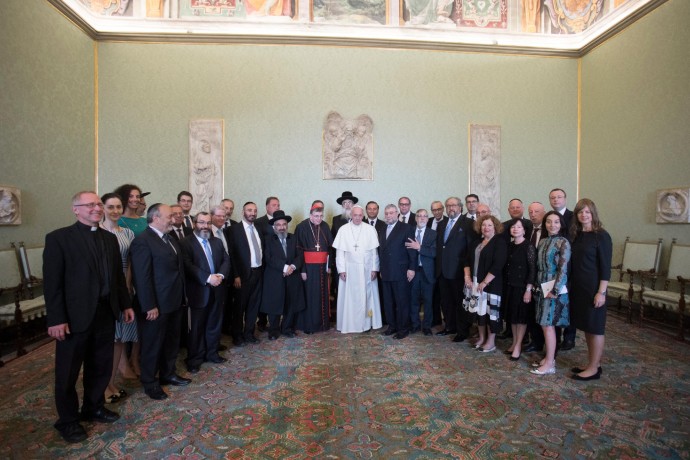When we see chief rabbis, rabbinical judges, cardinals and bishops meet, between the colorful robes and the large hats, the pictures can be quite striking, and such meetings can sometimes bring about important achievements, but mostly, the impact remains symbolic. To achieve meaningful impact, high-level meetings are not enough. What is needed are grassroots meetings, translating the message of peace, brotherhood, respect and support down to the practical and political level.
Last week, I was invited to represent the Conference of European Rabbis (CER) in Geneva as a keynote speaker at exactly such a conference, entitled Roots and Responsibility, Jews, Christians, and Our Common Future in Europe.
So how do we move from interfaith conferences to interfaith action? One guiding light is the 1964 article by Rabbi Joseph Ber Soloveitchik entitled “Confrontation,” in which the Rav urges Jews not to engage in theological dialogue with other faiths, but to seek to conduct the dialogue at eye level as a proud, authentic, independent faith community, granting the dialogue partner space for the same authenticity, pride and independence. The purpose of the interfaith encounter is not to trade theological favors, but to encounter one another and to act together. It goes without saying that ecumenical prayers were not the order of the day.

To some, abstaining from theological dialogue feels unnatural – an unbearable restraint – and indeed, in a 2018 letter to yours truly, the late Pope Benedict XVI expressed his hope that we in the Orthodox camp would agree to engage in joint Bible study and theological dialogue, a request to which I could not consent.
And yet, as we could vividly see during this conference, the depth and meaning of the interfaith relationship can better be measured by the willingness to act than by debating theology. Sure enough, one cannot assemble any significant number of religious leaders or laity without talking about faith and theology, and we indeed explored what the limits of dialogue are. However, once we switched from theory to action, we discovered how great the need of the hour is, and where our common action can truly make a difference.
One of the foundational values of modern Europe is religious freedom. Though it took centuries to percolate, it was with the Peace of Westphalia that Europe accepted that religious differences should not lead to war and misery. For the first time, governments, through the treaty, removed the ius reformandi. Subjects were no longer expected to follow the religion of their ruler. Of course, Jews would have to wait another few centuries for their rights to be respected.
However, in recent years, religious freedom has been curtailed time and again, being seen as secondary to other, newer rights. Additionally, Europe generally conceives of religious freedom in terms of freedom of conscience but isn’t always aware of the concomitant freedom of practice, which is how countries that pay lip service to protect the rights of minorities can also proscribe circumcision and circumscribe the right to produce food in accordance with one’s ethical and religious beliefs (cf. shehitah).
Though Jews and Muslims are the primary victims of these limitations on religious freedom, the majority faiths suffer, too. An intolerant secularist class has arisen, which is not content with its right to have freedom from religion and wants to constrain instead religious practices and centuries-old accommodations for those wishing to follow and practice their own religion.
In many jurisdictions, the secular orientation of the state is no longer interpreted as neutrality and reserved by the state to grant the citizenry more freedom, but rather a mandate to impose a secular space. Those who dare express their traditional attitudes are threatened with cancellation in the media (religious artists and writers do have a harder time accessing those media, even when producing neutral, objective art and other content), and even with legal action, as in the case of former the Finish interior minister who was charged with hate speech for tweeting verses from the Bible.
In many jurisdictions, actors are charged with making reasonable accommodations to grant religious people sufficient freedom to practice their religion, but increasingly universities and sports clubs are deaf to the needs of Shabbat observers. In 2021, the European Court of Human Rights ruled that a hijab can be banned at work, displaying the court’s inherent and subconscious bias as to what it considers normal and reasonable, and as to what kind of Europe it imagines: one in which religion is curtailed and limited to the most private spheres.
Against that backdrop, lay and religious leaders involved in combating bias and discrimination, in campus work, and active in NGOs debated how we can act together to defend and guarantee religious freedom in a multifaceted Europe, and how extending the hand of brotherhood across religious divides can be salutary to us all, without abstaining from authenticity in our religious commitments.
Rabbi Arie Folger is a member of the Standing Committee of the Conference of European Rabbis, ( CER ) and author of Rabbis in Conversation with the Vatican (German, Lit Verlag 2021).
